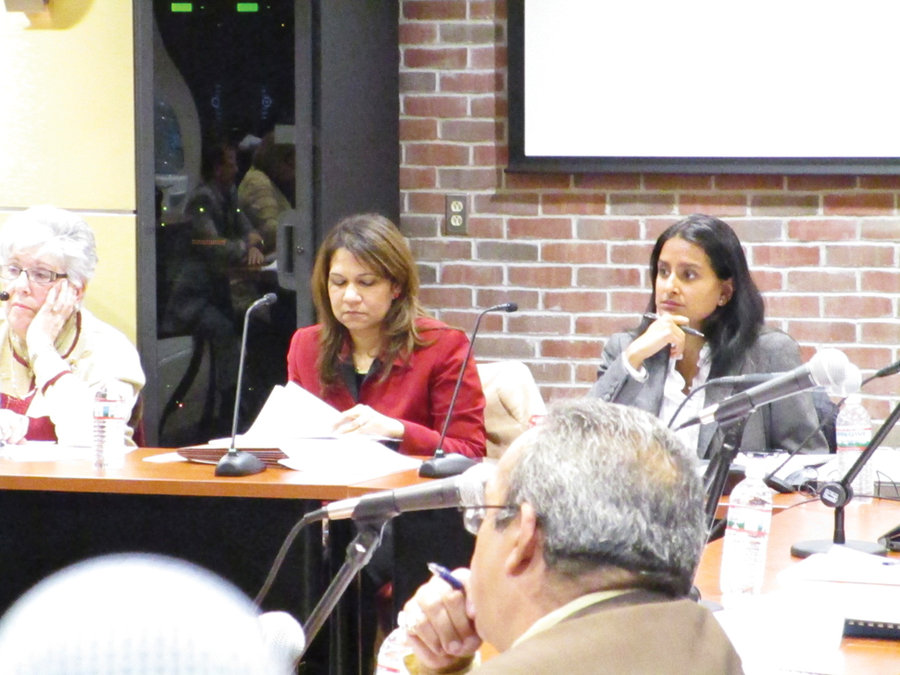Board of Education members are engaged in a debate over the future of a three-year strategic plan envisioned by the school administration for the district and implemented by a school board whose membership will change substantially next month.
The plan could redefine and limits how much power the elected board members will have over the day-to-day operations of the school district, assigning much of that power to the superintendent of schools.
A progress report on the “Jersey City Strategic Plan for 2014 – 2017,” first brought before the board in the spring of 2013, was presented at a board caucus meeting last Tuesday that was called to update board members.
The public can view a PDF copy of the plan online by searching Google for “Jersey City Strategic Plan for 2014 – 2017.”
Board member Marilyn Roman raised questions about its viability. She called the report “a pointless document” that lacked a clear plan of action, details about costs, or how strategies would be implemented.
Schools Superintendent Marcia Lyles, however, defended the plan as a work in progress.
“This plan cost the district $150,000. When its recommendations are implemented it will cost more.” – Marilyn Roman
____________
“The three-year plan is designed to gather information about the district over three years,” she said.
The sweeping strategic plan was largely endorsed the current lame-duck board, three of whom were voted out of office in November. It has the approval of one of the stronger parent groups, Parents For Progress, but is vehemently opposed by the Jersey City Education Association, the local teacher’s union. The JCEA is suspicious of the plan’s emphasis on teacher accountability.
Plan is already underway
While the board approved moving ahead with the plan in 2013, the implementation only happened at the end of the last school year in June. It is expected to yield data that will be reviewed at the end of the current year. Seen as a road map for the school district, the 54-page overview of the project is laden with bureaucratic jargon and requires numerous addenda to explain many of its multi-faceted elements.
Lyles said the plan would focus on five goals: preparing students for college and careers, shaping teaching practices and student support based on data collected, assuring accountability, help in recruitment of instructors and their retention, and to align “the form and function” of the school district to meet the needs of the staff, schools, and classrooms.
Another goal is to engage families and communities in support of the schools and advance the academic achievement of their students.
Roman asked for practical information on the costs of programs to be developed out of this study. She asked how they would be implemented. She was requesting practical details that the superintendent’s complex web of rhetoric and back-up documentation did not provide.
Board President Sangeeta Ranade, however, pushed back against Roman’s demands. She called the school board’s ability to manage programs limited, and said that day-to-day operations of the district are in the hands of the school superintendent and the administrative staff.
Ranade said the plan sets the direction and creates a model for the superintendent and her staff to follow. This differs from a corrective action plan, she said, which deals with more current events, problems that need to be rectified, and responds to specific needs. Lyles’s strategic plan is designed to look ahead and work towards goals, she said.
But Roman countered that Lyles’s plan will develop programs the board will need to pay for. She asked for a report on how much these programs will cost and where they will fit in the school budget.
Here come the consultants
Lyles’s plan also relies on the expertise of outside consultants, something that was an issue in the last school board election. Some of the newly-elected board members with whom Roman is aligned have vowed to look more closely at the use and cost of consultants once they are sworn in after the first of the year.
The plan includes the use of focus groups and a number of other innovations. Lyles said her plan is partly designed to revamp the school district’s approach to education, and to prepare teachers and students for new tough academic standards that previous educational models may not be adequate to address.
Roman said she is not interested in micro-managing the superintendent and her staff, but wants to oversee the costs associated with the plan’s recommendations.
“This plan cost the district $150,000,” she said. “When its recommendations are implemented it will cost more. I want to know what the price tags are. What is being done by who is the superintendent’s responsibility. I want to know what it costs before I vote on it. We’re in charge of the money here.”
Lyles assured Roman that the board would have measureable outcomes by the end of the three-year period. She said there would likely be a more detailed progress report next summer after the school year ends when the staff has time to review the data.
Al Sullivan may be reached at asullivan@hudsonreporter.com.
